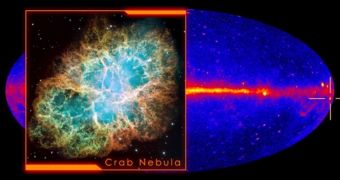About a month ago, the Crab Nebula flared up, and released a massive flare that was easily detected by telescopes monitoring the night sky. At this point, astronomers have no idea as to what may have caused the peculiar event, but theories are beginning to spring up.
In the past, experts have seen the massive supernova remnant flare up, but this event was five times stronger than anything else on record. Scientists at NASA and elsewhere are now struggling to explain the phenomena that could make such a flare possible,
The American space agency's Fermi Gamma-ray Space Telescope picked up the radiation spike coming from the nebula on April 12. The space object was releasing large amounts of gamma-rays, in a portion of the electromagnetic spectrum that the spacecraft is especially designed to detect.
What makes the new event very interesting is the fact that it followed only three months after a January gamma-ray flare, that also came from the Crab Nebula. The April flare lasted for about six days.
One of the possible explanations for the outburst is that it was produced by highly-energetic electrons, accelerated to energies about 100 times higher than the ones that can be obtained in any particle accelerator on Earth.
“These superflares are the most intense outbursts we've seen to date, and they are all extremely puzzling events,” expert Alice Harding says in a statement. She is an expert at the Greenbelt, Maryland-based NASA Goddard Space Flight Center (GSFC).
“We think they are caused by sudden rearrangements of the magnetic field not far from the neutron star, but exactly where that's happening remains a mystery,” she goes on to say, quoted by Space.
As it appears in visible-light wavelengths, the Crab Nebula is the remnant of a huge supernova blast, that marked the end of a massive star's burning cycle. After it violently shed its outer atmosphere, the object imploded, and formed a neutron star, which is now visible at the core of the nebula.
The explosion of the Crab Nebula precursor occurred a long time ago, but the light the event emitted only reached our planet in the year 1054. The neutron star is now located about 6,500 light-years from Earth, in the direction of the constellation Taurus.
“The Crab Nebula hosts high-energy variability that we're only now fully appreciating,” concludes Fermi Large Area Telescope (LAT) team member Rolf Buehler.
He holds an appointment at the Kavli Institute for Particle Astrophysics and Cosmology, a facility operated by the US Department of Energy's (DOE) SLAC National Accelerator Laboratory and the Stanford University.

 14 DAY TRIAL //
14 DAY TRIAL //